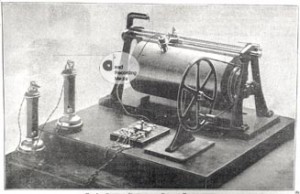
An early Poulsen Telegraphone

A later Telegraphone
The era of the phonograph also saw the introduction of an alternative recording technology that was little seen by the public but increasingly used in studios. Magnetic recording, which is today used for video and audio tape, was first introduced around 1899-1900 by the Danish inventor Valdemar Poulsen.
Poulsen envisioned that it would be useful for office dictation and telephone recording, but his “Telegraphone,” manufactured in the U.S. and Europe by various firms, never took off. It was virtually forgotten in the U.S., but inventors in Germany and England persisted. The earliest version of the Telegraphone looked a bit like a cylinder phonograph. For simplicity’s sake, the inventor wrapped the wire (onto which the recording was made) around a cylinder. The recording head tracked the wire along the surface.
The advent of electronic amplifiers for the Telegraphone in the 1920s and the introduction of an oxide-coated tape in place of the solid steel wires and bands used before resulted in steady improvements in sound quality. The BBC, the CBC, and the RRG (the German broadcasting agency), among others, used steel-band magnetic recorders extensively all through the 1930s.
By the end of the decade, the German companies AEG and I. G. Farben had improved the tape recorder and its coated-plastic recording medium to the point where it could approach the best disc recorders in sound quality. Its ability to make very long recordings and recordings under conditions of vibration and shock helped make the “magnetophon” popular for field and telephone surveillance recordings as well. For radio broadcasting, the best studio magnetophons rivaled or exceeded high quality American and British disc recorders by the time Berlin fell in the spring of 1945.

World War II -era magnetophone
This AEG magnetophon was one of several versions of the technology developed in Germany between the early 1930s and 1945. Like modern audio and video recorders, it employed a plastic tape coated with a layer of extremely fine iron powder (modern recorders use different mixtures of iron and other materials).